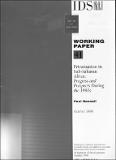| dc.description.abstract | Privatisation of both the ownership and control o f state-owned enterprises (SOEs) is an
increasingly central feature o f all national economic reform programmes in sub-Saharan
Africa (SSA). In those countries where SOEs have dominated all or most sectors o f the
formal economy, comprehensive privatisation programmes are regarded (particularly by the
World Bank and the IMF) as being o f crucial importance for the future development o f a
strong private sector which, in many respects, has become the superordinate medium-long
term objective o f adjustment programmes everywhere in Africa. Privatisation is also justified
on the grounds that SOEs are invariably inefficient and, without decisive interventions, will
continue to be a massive drain on extremely limited public resources (see World Bank, 1995).
The article is structured as follows. Section 2 briefly describes the sources and types o f data
that were included in the survey. Section 3 presents an overview o f the number, value, type,
and ownership characteristics o f privatisations between 1980 and 1995 disaggregated by
country and main economic sector. Sections 4 and 5 then discusses how the design and
implementation o f privatisation programmes in SSA have been affected by a number o f key
political and economic factors. Section 6 reviews the limited evidence that is available on the
performance of privatised SOEs. Finally, section 7 considers the prospects for privatisation in
SSA during the next five years.
Data from five main sources were utilised for the survey, (i) The Candoy-Sekse and Sader
data bases for the periods 1980-1987 and 1988-1992 respectively, (ii) Unpublished data from
the World Bank that partially updates the Sader data base up to and including 1995. (iii)
Reports and other documentation produced by government commissions, committees and
units that have been specially established, often with technical assistance from the World
Bank and other donors, to design and implement privatisation programmes in SSA. Basic
information on all transactions was obtained from almost all countries that have had active
privatisation programmes during the 1990s, including Burkina Faso, Cote d'Ivoire, Ghana,
Kenya, Mozambique, Nigeria, Tanzania, Uganda, and Zambia.4 (iv) Information provided by
country desk officers for SSA, and staff o f the Private Sector Department at the World Bank;
and (v) A variety o f other publications including the local and international business media.
Grey cover World Bank reports on private sector development were particularly useful for a number of countries. | en_GB |

